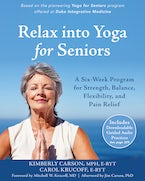By Jim Carson, PhD, Kimberly Carson, MPH, C-IAYT, and Carol Krucoff, C-IAYT, E-RYT, coauthors of Relax into Yoga for Chronic Pain
Humans have a very complicated relationship to pain. This complex relationship is evident in the word itself. Derived from the Latin poena—meaning “punishment, penalty”—pain has historically been considered a punishment for sin. Ancient Greeks viewed pain as one of the passions—or “agitations of the soul”—more like an emotion than a sensation. Even today, some people think, often subconsciously, that their suffering must be rooted in something they’ve done wrong.
But in recent years, scientific advances have revolutionized our understanding about the complex neurobiology of pain. Modern imaging techniques provide insight into how the brain works, and have revealed surprising information, including the fact that pain can be contagious—that is, the same areas of the brain “light up” in caregivers of someone with chronic pain as in the person experiencing pain. Brain scans of people suffering from chronic pain show activation in different areas than in people experiencing temporary pain. In addition, chronic pain activates numerous areas of the brain, including those responsible for problem solving, memory, movement, emotion, sensory discrimination, and the stress response. In other words, the brain is working hard to try everything it can to keep the system safe and provide relief.
In fact, many experts say that chronic pain should be treated as a distinct disease that is very different from acute or temporary pain. Like a software glitch in the computer of our brain, chronic pain results from “faulty rewiring” that occurs when pain has persisted over several months and our brains have been busily rewiring neural circuits in an attempt to find relief. Although the original injury that started the pain may be healed, the experience of chronic pain continues and is affected by thoughts, feelings, memories, and other inputs.
This is where Mindful Yoga can offer profound relief. Our studies of people with various chronic pain conditions support the likelihood that the tools of yoga—such as meditation, breathing, and gentle movement—can help people “rewire” the faulty circuitry in their brain to restore a healthier pain response. One top scientist put it this way: “Practicing yoga has the opposite effect on the brain as does chronic pain.”
At a meeting of the American Pain Society, M. Catherine Bushnell, scientific director of the National Center for Complementary and Integrative Health, noted that chronic pain causes changes to brain anatomy, and said that yoga can be an important tool for preventing or even reversing the effects of chronic pain on the brain. “The encouraging news for people with chronic pain,” she said, “is [that] mind-body practices seem to exert a protective effect on brain gray matter that counteracts the neuroanatomical effects of chronic pain.”
If you’re new to exploring how yoga practices can help with your pain, we recommend you start with learning a very soothing and effective breathing technique called Three Part Breath, as described below. Next, order our new book, Relax into Yoga for Chronic Pain, which will guide you step by step to find the relief and resilience you need and deserve.
Free Download: The Three-Part Breath Audio Meditation
Three-Part Breath
The Three-Part Breath can be done anywhere and anytime, multiple times a day or at night. While you can do this practice in any position—lying down, sitting, or standing—it’s easiest to learn when you’re lying down or sitting in a reclined position. Try this breath for a few moments (5-7 complete rounds) and then notice how you feel.
Part 1 – Rest your hands on your belly, just below the navel. As you take your next breath in, let your belly soften and expand like a balloon. As you breathe out, let your belly sink. Repeat three times.
Part 2 – Rest one hand on your ribs and one hand on your belly. With your next inhale, let your belly soften, and allow your ribs expand to the left and to the right. As you exhale, let everything sink. Repeat three times.
Part 3 – Rest the hand that was on your ribs on your upper chest, just below your collarbones. As you breathe in, allow your belly to soften, your ribs to expand, and your upper chest to broaden. As you exhale, let everything relax back down. Spend a few moments in this three-part rhythm, letting the breath open and nourish your body.
As this breath begins to feel more familiar, explore letting your breath be as full in your back body as in your front body—so that as you breathe into your belly, there is also a gentle expansion through your lower back; as the ribs of your front body expand, so do the ribs in your back body; and as your upper chest broadens, so does your upper back.
When you’re ready to finish, just let your breath fall back into its natural rhythm, and notice the impact of the Three-Part Breath.
Jim Carson, PhD, is a former yogic monk (swami) who has taught the practices and philosophy of yoga worldwide for more than forty-five years. Jim is now a clinical health psychologist; and associate professor of anesthesiology, and of psychiatry at Oregon Health and Science University (OHSU) in Portland, OR. He has applied his expertise to the development and evaluation of yoga and meditation-based clinical treatments, including the first mindfulness program for couples, the first loving-kindness meditation program for medical patients, and the Mindful Yoga program.
Kimberly Carson, MPH, C-IAYT, is a mindfulness educator and yoga therapist at OHSU; specializing in the therapeutic use and scientific study of mindfulness and yoga for people with medical challenges. Kimberly currently offers mindfulness and yoga programs to chronic pain, cardiac, oncology (inpatient and outpatient), and internal medicine patients, and has taught mindfulness-based stress reduction (MBSR) for more than twenty years.
Carol Krucoff, C-IAYT, E-RYT, is a yoga therapist at Duke Integrative Medicine in Durham, NC; where she offers private sessions, workshops, and classes for people with health challenges. An award-winning journalist, Carol served as founding editor of The Washington Post Health section, and her articles have appeared in numerous national publications, including The New York Times, Yoga Journal, and Reader’s Digest. She is author of several books, including Yoga Sparks and Healing Yoga for Neck and Shoulder Pain.



 2024 Peace Playbook: 3 Tactics to Avoid Clashes with Your Partner
2024 Peace Playbook: 3 Tactics to Avoid Clashes with Your Partner